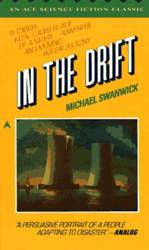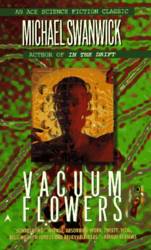

| Click on a book's image or title to order from Amazon.com |

In The Drift
Ace, © 1985, 195 pp, ISBN #0-441-35869-1Reviewed June 1997
In The Drift is a collection of linked short stories, taking place about a century after Three Mile Island went up - only in this story it really did go up, blanketing the region from Hartford to Philadelphia with radiation, and throwing the United States into chaos from which it never really recovers. This region is known as the Drift.
The novel takes place over several decades. In the opening story we meet the young Keith Piotrowicz, a Philadelphia native who encounters Fletch, an older woman from the Northeast who's doing research on the Drift. The Mummers, the ruling body of Philadelphia, but a death sentence on her head and Keith's, because she knows that Philadelphia isn't a haven just outside the drift, but in fact lies within its bounds. In this way, Swanwick shows us the bleakness of the situation by illustrating the desperate beliefs of those who live at the edge of the Drift.
The novel slowly moves deeper and deeper into the Drift, heading north from Philly. Keith ingratiates himself to the Mummers by taking advantage of a standoff between Fletch, her friends, and the Mummers, in which Keith is the only survivor. Keith moves up the Mummer Hierarchy.
The third installment, "Boneseeker", concerns Samantha, a young woman who is effectively a vampire, in the sense that radiation damage has resulted in her being unable to eat anything but meat. When she is consigned to a slave camp in the Drift, she finds that she is implicitly able to sense the presence of radiation, can determine how long people have to live, and acquires a near-religious following. In the process, we learn that Keith, now a leader among the Mummers, is using her to get to her father, a military strategist helping to create the slave camps in the Drift to mine the region's one remaining resource - coal. Sam falls for Keith, and eventually has a daughter by him.
That daughter, Victoria, is a pivotal figure in the final chapter, "Marrow Death", involving the small efforts of Drift residents to reclaim their land from the invaders from the US and the northeast. By this time, Keith is clearly on the opposing side, aiding and abetting the invaders, apparently no longer aware of what is good for his land.
Swanwick pulls few punches in In the Drift, although to his credit he rarely plunges into gore, despite the grisly material. Nor does he treat the situation along the nearly comical lines of the effects radiation has in comic books; there are no super-powers here, there are only tumors, deformities, and life spans shortened to a mere 20 years. It's a very effective portrayal of what life might be like under perhaps the most hostile conditions imaginable on Earth.
Swanwick imbues his characters with a vaguely mystical quality, and though he sometimes seems to be winking at us (Victoria isn't really a prophet an savior of the Drift, is she?), he also leaves some elements clearly unexplained, relying solely on their dramatic impact (such as peoples' reactions to Sam and Victoria's ability to sense radiation). Characters in the book are uneducated, unbalanced, or sharply influenced by their dour environment. The final effect of this is to produce a sort of dark side of The Lord of the Rings, as characters struggle to save what they can in a land which cannot be saved, which clearly fell under the power of the dark lord long before any of them were born. The reader at once wonders why anyone would bother, even while admiring the courage of the characters.
Swanwick's prose is wonderfully evocative, and the often-mild tone adds to the atmosphere of the story. As a short, sharp cautionary statement,
Vacuum Flowers is the story of Rebel Elizabeth Mudlark - sort of. In fact, Rebel had died some time before the story begins, but her personality had been recorded in the wake of her death, and the company which owns the recording, Deutsche Nakasone, tries to determine the suitability of marketing her personality commercially. To that end, a "personality bum", Eucrasia Walsh, tests out the personality by loading it into her mind. Problem is, she decides she likes it, erases the original, and escapes, with Deutsche Nakasone
in hot pursuit.
Vacuum Flowers is also a tour of the future solar system which Swanwick has concocted, in which Earth is ruled by the Comprise, which is nothing more than the electronically linked collective minds of the planet's population. In the wake of an unsuccessful attempt to spread to the rest of the solar system, the Comprise is now searching for a way to leave the planet while overcoming the communication lag imposed by light speed; meanwhile, the rest of humanity lives on Mars (which is being terraformed) and out in the asteroids on vicarious space stations.
The novel is structured as a "grand tour" of the solar system; Rebel awakens in Eucrasia's body in the belt, and leaves in the company of her lover Wyeth, who has been programmed with four personalities, to escape Deutsche Nakasone. Wyeth fancies himself the arch-enemy of the comprise, whose assault on individual humanity he identifies as a threat to the survival of the species. So Rebel is inexorably dragged to Mars, then to Earth, both to escape her own fate and to accompany Wyeth in his.
Vacuum Flowers is a very busy book, tackling many different cutting-edge issues to differing depths, but at its core it's a book about power: Wyeth resents the destructive nature of the Comprise toward individual personalities, even as the Comprise argues that it is the next logical step in human evolution. This clearly is an argument that neither side can win, though the reader sides with Wyeth simply because the Comprise is so alien to our own notions of what humanity is. But Swanwick presents the other side perhaps as reasonably as anyone could.
The power of Rebel's love for Wyeth is seemingly the element which prevents her implanted personality from decaying back into Eucrasia, an event which we are led to believe is inevitable (and which seems inexplicable by any other means). But that love also causes Rebel to use some power she has over Wyeth's own programmed personalities to force him to abandon her cause and join her in leaving the solar system entirely. Swanwick appropriately muddies the moral issues involved in individual rights and liberties when personalities can be programmed and overwritten with relative ease. (It's unclear whether Swanwick has his own answers to some of these issues, not that he should be expected to, of course.)
Incidentally, it's interesting to contrast the Comprise with Raphael Carter's Unanimous Army in her novel The Fortunate Fall; The Army had attempted the same unity of mankind as the Comprise, but failed. Carter painted her Army as more clearly villainous than the vaguely sympathetic Comprise, too. It's also worth nothing that Vacuum Flowers was published not long before the far more famous Borg first appeared in Star Trek: The Next Generation; coincidence, or not?
Vacuum Flowers is an interesting tapestry of ideas and settings, although a bit weak on character and plot. Still, the density and quirkiness of the concepts and their exploration make this one worth reading.

Vacuum Flowers
Ace, © 1987, 248 pp, ISBN #0-441-85876-7
Reviewed May 1997
hits since 13 August 2000.